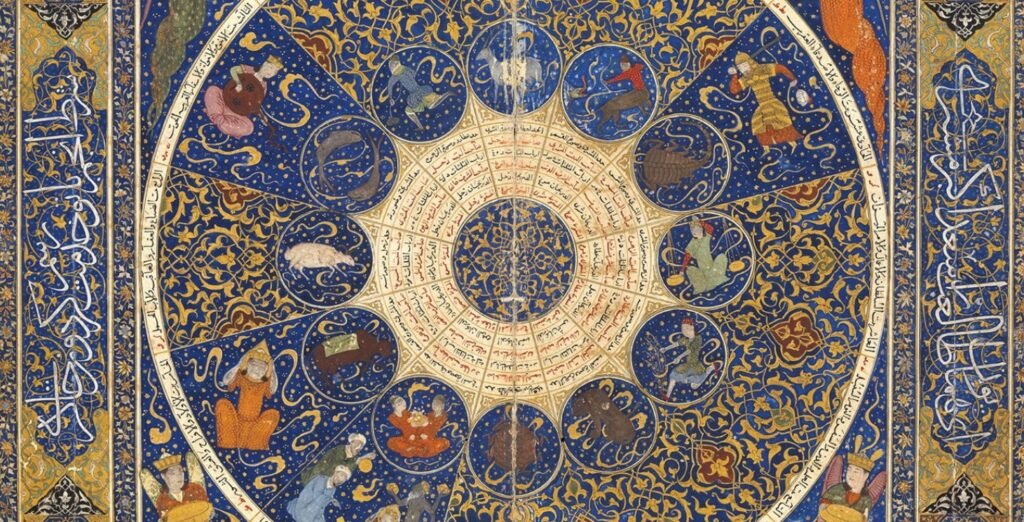
“Astrology reveals the will of the gods” remarks Juvenal.This very idea came to existence around the 3rd-millennium bc.It comprises the prophecies of earthly and human events predicted with the help of stars,sun, moon and the planets. It is believed that the destiny of an individual can be understood through astrology. The prevalence of astrology in the Islamic world was seen from the 8th century AD. This tradition was passed on to Mughals through Turko-Mongol connections.According to Eva Orthmann, “The Mughals used narratives or birth charts of emperors to emphasize their kingliness through distinguishing themselves from the predecessors by establishing their greatness as written in stars.”
Apart from this, both Arabic and Persian traditions along with Hindu heritage left a significant impression on the astrological beliefs. For example, both Hindu and Persian concepts had a great influence on the Mughal practices of sun worship like the ‘darshan ceremony’ and the divine glory’.
Under the Mughal rule, astrology was seen as a means to amplify the legitimacy of the ruler and to portray the ruler’s remarkable position. Among the Mughals, Humayun was mainly remembered in history for his astrological background as he was influenced by his father Babur,a patron of astrology. Pictorial depictions show him holding a pair of compasses in his hands.Moreover, historiographical sources like Akbarnama and the dynastic paintings provides significant evidences for the practice of astrology by Babur, Akbar and his successors.In addition Mughal architecture also indicates some relation to astrological elements.
Akbarnama highlights Humayun’s(1530-40 and 1555-56) interest in astrology and alchemy. According to Khawan Amir, Humayun wore different coloured garments everyday according to the colour of the planets.For example, on Saturday he used to wear black, the color of Saturn and on Sunday he would wear yellow, the color of the sun. Some sources suggest that when he died by falling down the steps from his library, he was there on the roof and was there to watch the movement of Venus. He wanted to promote his officers based on this event.Moreover, Humayun also developed a round carpet (basalt-i nishat), which was divided into eleven concentric circles in which elements like water and earth were placed in the middle and the outer edge has the atlas sphere. The remaining circles were associated with the colors of seven planets and the emperor’s officers were made to sit in their allotted circles based on their rank. Along with this he also constructed a double-walled tent whose outer covering was white and the inner part was possibly blue in color. The inner tarpaulin had twelve sections indicating twelve zodiac signs and thus, provided an agile representation of stars and the atlas sphere. A palace having seven rooms was also devoted to each planet of the solar system. Firishta throws light on Humayun and tells that he would hold his audience every day in the room specifically allocated to that day’s ruling planet and would address issues linked to it. The Emperor tried to replicate the sun’s daily and annual course by portraying himself as the rising sun during the ceremony of Darshan and a similar practice was followed by Akbar. A huge encyclopedia named ‘Jawahir al ulum-i Humayuni’ shows Akbar’s deep interest in astrology.In addition, the right occasion for commencing the foundation of a fortress and war was also determined by astrology.Humayun’s famous “Mystic House”, shows celestial connotations as its octagonal rooms reflected the octagonal alignment of the universe and had four directions. The emperor occupied the central place in it.
In paintings, astrologers were mainly presented in the court scenes specifically during birth events. Later,they played the role of advisor to the king as well.
Abul Fazl’s Akbarnama is one of the finest examples which gives references for the use of astrology. For example, the description of Humayun’s reaction to Akbar’s horoscope during his birth provides a clear picture of astrology. Moreover,the thousand-year time period clearly emphasizes Akbar’s millennial aspirations. His later success was predicted by the planetary positions at the moment of birth and the houses. Moreover, a comparison was also made between Timur and Akbar’s horoscopes. Timur was the lord of conjunctions and a symbol of legitimation for the Mughals to which Akbar’s destiny was subordinated. Along with this, his deeds and activities depended on superior forces.
During Akbar’s reign(1556-1605), not many astrological texts were produced. We find solar and astrological alignments being prevalent in the garden containing Akbar’s tomb as the upper storey of the tomb was kept open showing the sky.The six-pointed star used in Humayun’s tomb was an auspicious sign in Islamic astrology signifying the union of opposite elements.
Moreover, astrology-themed coins were issued by Jahangir(1605-1627) and were the second known example of zodiac currency in the world. His coins contain twelve zodiac signs having the sun in the background. According to Stefano Carbon, the use of the sun was seen as a substitute for the emperor’s image. It might have been issued by the emperor to claim his authority in both the earthly and heavenly realms.
During Shah Jahan’s(1628-58) birth, it was predicted that he would attain ‘the citadels of glory’. Aurangzeb’s reign(1658-1707) saw a moderate role of astrology in the decision-making of the ruler and administrators.
Astrology was a way to establish a worldview which was rooted in natural philosophy and was suitable for people regulating the natural forces. A celestial space was built for the emperor as solar motives and images of animals that were associated with heaven were placed on the emperor’s throne. For example, the peacock depicted in the throne is believed to be a guardian of the solar disc. Also, the Mughals track their lineage to ‘Alanquwa’ and through it to the sun.The use of sun and moon motifs highlights the emperor’s proximity to divinity and sainthood.
Overall,astrology played an important role during Mughal rule mainly in state affairs,marriage,military campaign and personal growth as the emperor would do a work seeing the planetary activities.It was highly appreciated field of study and its influence can be clearly understood through Mughal architecture,culture,art and literature which was further developed in future.

Sanskriti Pundir
Sanskriti Pundir is currently pursuing a Bachelor's degree in History Honours from Indraprastha College for Women. She is determined and is also a budding writer who actively seeks opportunities to improve her writing skills.

